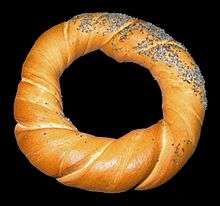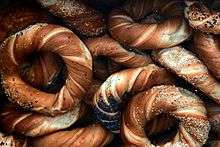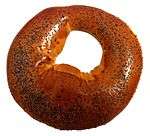Obwarzanek krakowski
An obwarzanek krakowski (Polish pronunciation: [ɔbvaˈʐanɛk kraˈkɔfskʲi], plural: obwarzanki krakowskie [ɔbvaˈʐaŋkʲi kraˈkɔfskʲɛ]; also spelled obarzanek[1]) is a braided ring-shaped bread that is boiled and sprinkled with salt and sesame or poppy seeds before being baked. It has a white, sweetish, moist and chewy crumb underneath a crunchy golden-brown crust. Traditionally sold from street carts, it is a popular snack in the Polish city of Kraków, where it has the status of a regional food with protected geographical indication. It is closely related to, but distinct from, bagels, bubliks and pretzels.
 An obwarzanek krakowski sprinkled with poppy seeds | |
| Type | Street food |
|---|---|
| Region or state | Kraków, Poland |
| Associated national cuisine | Polish |
| Serving temperature | Room temperature |
| Main ingredients | Wheat flour, fat, yeast, sugar, salt |
| Ingredients generally used | Coarse salt, poppy seeds, sesame seeds (for sprinkling) |
| Variations | Depend on the sprinkling |
| Similar dishes | Bagel, bublik, pretzel |
Etymology
The term obwarzanek krakowski is Polish. The Polish noun obwarzanek, or obarzanek, derives from the verb obwarzać, "to parboil",[2] which refers to the distinctive technique of boiling the dough before baking. The adjective krakowski denotes anything coming from or related to the city of Kraków.
Description
An obwarzanek krakowski is a ring-shaped baked product. It takes the form of an oval or, seldom, a circle with a hole in the middle. Its surface is formed by strands of dough, round or oval in cross-section, twisted into a spiral. The colour ranges from light golden to light brown, with a distinct sheen. A typical obwarzanek is 12–17 centimetres (5–7 in) in diameter, 2–4 cm (0.8–1.6 in) thick, and weighs 80–120 grams (3–4 oz).[3]
The visible strands of the spiral on the crust are firmish to the touch and the surface varies from smooth to slightly rough. The crumb inside is pale, soft and slightly moist. The taste is sweetish, which is typical of bakery products that are first parboiled and then baked. Obwarzanki are traditionally decorated by sprinkling them with various ingredients, including coarse salt, poppy seeds, sesame seeds, flax seeds, nigella seeds, mixed herbs or mixed spices (paprika, caraway, pepper), grated cheese, onion flakes, etc.[3]
Ingredients and preparation

The dough for obwarzanki is made from wheat flour, up to 30 percent of which may be replaced with rye flour. Other ingredients, per 100 kilograms (220 lb) of flour, include:
- 2–3 kg (4–7 lb) of fat,
- 2–4 kg (4–9 lb) of sugar,
- 1–2 kg (2–4 lb) of yeast,
- 1–1.5 kg (2–3 lb) of salt,
- 40–48 litres (9–11 imp gal; 11–13 US gal) of water.[3]
The dough is prepared using the single-stage method. Once suitably mixed, the dough is set aside for initial rising, which may take from a few minutes in summer to an hour in winter. The dough is divided into small portions, which are rolled out and cut into strips. The baker twists two or three strips into a spiral and then forms a ring by twisting them around his hand and presses it against the table. The ring is placed on a board or mesh for proofing, and then parboiled in water with a temperature of at least 90 °C (194 °F) until it rises to the surface. The water may be sweetened with very small amounts of honey. The obwarzanek is then decorated and baked.[3]
Once it has cooled, an obwarzanek may be placed in packaging. If packaged before it has cooled, it quickly loses its crunchiness and becomes rubbery. Obwarzanki are usually sold unpackaged and unlabelled.[3]
History

The earliest known references to obwarzanki being baked in Kraków, Poland's former royal capital, appear in the accounts of the court of King Vladislaus II Jagiełło and his consort, Queen Hedwig. An entry dated to 2 March 1394 mentions the product using both its Polish name and its equivalent in Polish Medieval Latin, circuli,[4] or "rings": "for the queen, for rings of obwarzanki [pro circulis obarzankij], 1 grosz".[3][5]
In 1496, King John Albert granted the bakers' guild of the city of Kraków a monopoly on baking white bread, including obwarzanki. This privilege was subsequently confirmed by all Polish kings up to John III Sobieski. Initially, obwarzanki could be made only during Lent by bakers specially designated for that purpose by the guild. The guild issued a decree in 1611 regulating the sale of obwarzanki inside the city walls and the choice of bakers who were allowed to sell them.[3]
A radical change took place in the 19th century. On 22 January 1802, a decree was signed which stipulated that any baker had the right to bake obwarzanki when it was his turn to do so. The bakers authorised to bake obwarzanki were selected by the drawing of lots. The custom of drawing lots probably ended in 1849, there being no evidence that it continued after that date. This could mean that, over time, the rules were relaxed and any baker could make obwarzanki on any day of the year, as is still the case today.[3]
Obwarzanki were sold from stalls which opened before 6 a.m. so that the inhabitants of Kraków could buy them freshly baked early in the morning. The guild monitored the quality and freshness of the products, eight of its members being responsible for carrying out checks on stalls. Any transgressions were severely punished. Eventually, people started selling obwarzanki in other ways. As late as the 1950s, they were sold straight from wicker baskets.[3]
In modern times, obwarzanki have been sold not only in shops and bakeries, but also from street carts. There are between 170 and 180 such carts offering obwarzanki in Kraków today. An average of almost 150,000 are sold on the Kraków market in a single day.[3]
The obwarzanek krakowski often features in campaigns to promote Kraków. As a well-known symbol of Kraków and Lesser Poland, it is often used in advertising aimed at locals and tourists alike. It has also won an award at the Nasze Kulinarne Dziedzictwo (Our Culinary Heritage) competition, and received a prize at the 2003 Polagra Farm international fair in Poznań. It always features at the Święto Chleba bread festival, an event that is held regularly in Kraków.[3]
See also
References
- Słownik języka polskiego PWN.
- Balinska (2008), p. 15.
- PL-PGI-005-0674.
- Dembińska (1999), p. 115.
- Przezdziecki (1854), p. 304.
Sources
This article incorporates some text from Council Regulation (EC) No. 510/2006, "Obwarzanek krakowski" EC No. PL-PGI-005-0674 as published by EUR-Lex. According to the website's copyright notice, "except where otherwise stated, reuse of the EUR-Lex data for commercial or non-commercial purposes is authorised provided the source is acknowledged ('© European Union, http://eur-lex.europa.eu/, 1998-2016'). The reuse policy of the European Commission is implemented by the Commission Decision of 12 December 2011."
- "obwarzanek". Słownik języka polskiego PWN. Wydawnictwo Naukowe PWN. Retrieved 2019-11-29.
- Balinska, Maria (2008). The Bagel: The Surprising History of a Modest Bread. New Haven and London: Yale University Press. ISBN 978-0-300-11229-0.CS1 maint: ref=harv (link)
- Council Regulation (EC) No. 510/2006, "Obwarzanek krakowski" EC No. PL-PGI-005-0674 of 16 February 2010. Retrieved 16 April 2016.
- Dembińska, Maria (1999). Weaver, William Woys (ed.). Food and Drink in Medieval Poland: Rediscovering a Cuisine of the Past. Philadelphia: University of Pennsylvania Press. ISBN 0-8122-3224-0.CS1 maint: ref=harv (link)
- Przezdziecki, Alexander (1854). "Życie domowe Jadwigi i Jagiełły: z regestrów skarbowych z lat 1388–1417" [Private Life of Hedwig and Jagiełło: From Treasury Registers of 1388–1417]. Biblioteka Warszawska (in Polish). Warszawa: Drukarnia Stanisława Strąbskiego. 2: 299–320.CS1 maint: ref=harv (link)
Further reading
- Czaja, Izabela; Gadocha, Marcin (2008). Obwarzanek krakowski: historia, tradycja, symbolika [Obwarzanek Krakowski: History, Tradition, Symbolism] (in Polish). Kraków: Bartosz Głowacki. ISBN 9788392686705.
External links


